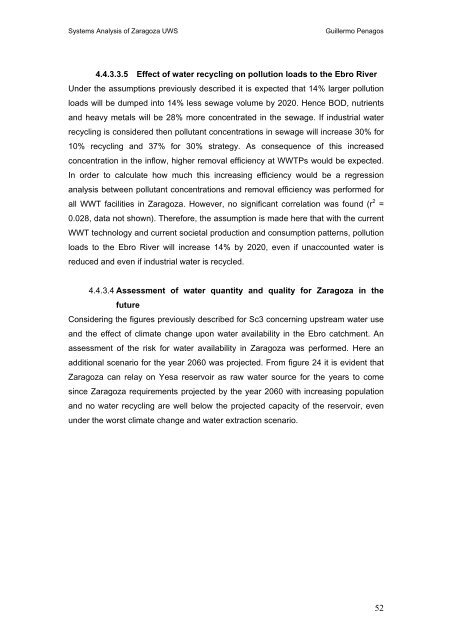Systems Analysis of Zaragoza Urban Water - SWITCH - Managing ...
Systems Analysis of Zaragoza Urban Water - SWITCH - Managing ...
Systems Analysis of Zaragoza Urban Water - SWITCH - Managing ...
You also want an ePaper? Increase the reach of your titles
YUMPU automatically turns print PDFs into web optimized ePapers that Google loves.
<strong>Systems</strong> <strong>Analysis</strong> <strong>of</strong> <strong>Zaragoza</strong> UWS<br />
Guillermo Penagos<br />
4.4.3.3.5 Effect <strong>of</strong> water recycling on pollution loads to the Ebro River<br />
Under the assumptions previously described it is expected that 14% larger pollution<br />
loads will be dumped into 14% less sewage volume by 2020. Hence BOD, nutrients<br />
and heavy metals will be 28% more concentrated in the sewage. If industrial water<br />
recycling is considered then pollutant concentrations in sewage will increase 30% for<br />
10% recycling and 37% for 30% strategy. As consequence <strong>of</strong> this increased<br />
concentration in the inflow, higher removal efficiency at WWTPs would be expected.<br />
In order to calculate how much this increasing efficiency would be a regression<br />
analysis between pollutant concentrations and removal efficiency was performed for<br />
all WWT facilities in <strong>Zaragoza</strong>. However, no significant correlation was found (r 2 =<br />
0.028, data not shown). Therefore, the assumption is made here that with the current<br />
WWT technology and current societal production and consumption patterns, pollution<br />
loads to the Ebro River will increase 14% by 2020, even if unaccounted water is<br />
reduced and even if industrial water is recycled.<br />
4.4.3.4 Assessment <strong>of</strong> water quantity and quality for <strong>Zaragoza</strong> in the<br />
future<br />
Considering the figures previously described for Sc3 concerning upstream water use<br />
and the effect <strong>of</strong> climate change upon water availability in the Ebro catchment. An<br />
assessment <strong>of</strong> the risk for water availability in <strong>Zaragoza</strong> was performed. Here an<br />
additional scenario for the year 2060 was projected. From figure 24 it is evident that<br />
<strong>Zaragoza</strong> can relay on Yesa reservoir as raw water source for the years to come<br />
since <strong>Zaragoza</strong> requirements projected by the year 2060 with increasing population<br />
and no water recycling are well below the projected capacity <strong>of</strong> the reservoir, even<br />
under the worst climate change and water extraction scenario.<br />
52
















